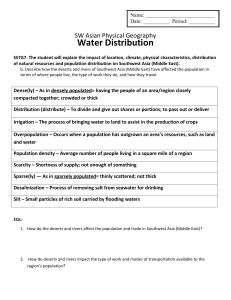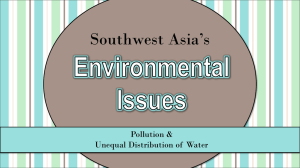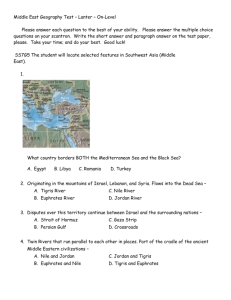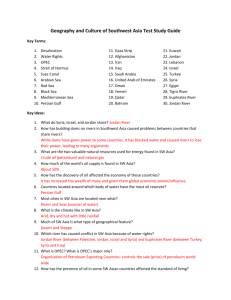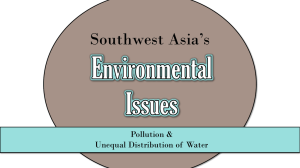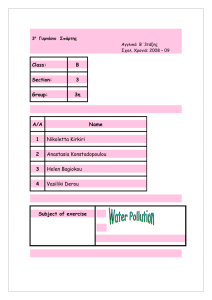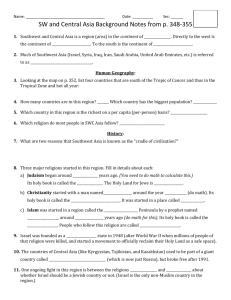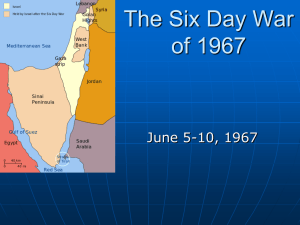Environmental Issues in Southwest Asia
advertisement
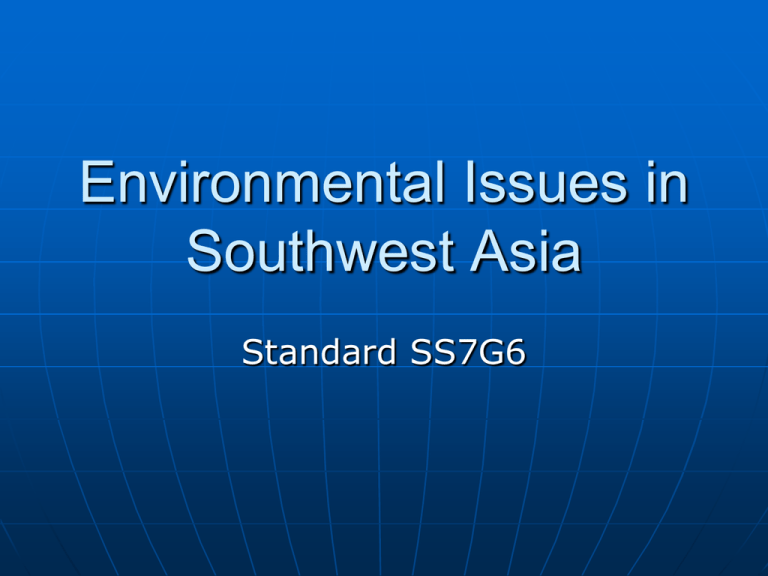
Environmental Issues in Southwest Asia Standard SS7G6 SS7G6 The student will discuss environmental issues across southwest Asia (Middle East) a. Explain how water pollution and the unequal distribution of water impacts irrigation and drinking water Enduring Understanding Students will understand that humans, their society, and the environment affect each other. Where have we seen that EU before? Essential Questions How do water pollution and the unequal distribution of water impact irrigation and drinking water in Southwest Asia? How has the distribution of oil affected the development of Southwest Asia (Middle East)? How do the deserts and rivers of Southwest Asia (Middle East) affect the population in terms of where people live, the type of work they do, and how they travel? WATER WARS “Indeed water is already a catalyst for regional conflict” Quote from the influential head of environmental research institute Worldwatch,Lester Brown. The world's supply of fresh water is running out. Already one person in five has no access to safe drinking water. Oil has always been thought of as the traditional cause of conflict in the Middle East but now countries fight over water. Map of the countries in the middle east fighting over water supplies WATER WARS: Middle East The 10 countries with the least amount of water in cubic metres (m³) Country 1955 1990 2025 Kuwait 147 23 9 Qatar 808 75 57 Bahrain 1,427 117 68 Saudi Arabia 1,266 306 113 Jordan 906 327 121 Yemen 1,098 445 152 UAE 6,196 308 176 Israel 1,229 461 264 Tunisia 1,127 540 324 Algeria 1,770 689 332 Water is the most precious resource in the Middle East, more important even than oil. Competition for water from the River Jordan was a major cause of the 1967 war. As populations increase, water becomes more scarce. Let’s Discuss Why is water more important than oil? Google the following: How much water is needed per day to survive? How many people live in the Middle East Region? How much fresh water is available in the Middle East Region? Israel and Syria The Lebanese have long accused Israel of having designs on the waters of the River Litani, and Syria accuses it of being reluctant to withdraw from the banks of the Sea of Galilee, the source of up to 30% of Israel's water. Israelis in the West Bank use four times as much water as their Palestinian neighbours. Turkey has been accused by Syria and Iraq of depriving them of muchneeded water, as it continues to build a series of dams along the Euphrates and Tigris. It is also embarking on an ambitious project to sell water from its Manavgat river across the Middle East. THIS SHOWS THE LIST OF MIDDLE EAST COUNTRIES WHICH WILL SUFFER FROM WATER SCARCITY IN THE NEXT 15 YEARS 1955 1990 2025 Bahrain Jordan Algeria Israel/ Palestine Egypt Iran Kuwait Qatar Saudi Arabia UAE Oman Syria Yemen Desalination Desalination is the process of removing salt from sea water to make it suitable for farming and drinking. Why do you think countries in SW Asia use this process? Problems with Desalination It is very costly for countries to use this process. Many countries in the Middle East cannot afford to use this process. In your opinion, which countries in the Middle East could afford this process? A Question for YOU What impact will the scarcity of water have on the Middle East in years to come? Water Pollution in The Middle East What is water pollution? While water pollution is a serious problem anywhere, why is this an even more serious problem in the Middle East? What would be the consequences of water pollution in the Middle East? SS7G6 continued b. Describe how the deserts and rivers of SW Asia (Middle East) have affected the population in terms of where people live, the type of work they do, and how they travel. How do the physical features of SW Asia affect where people live? Think about where deserts and rivers are located in SW Asia. Look at an atlas, pages 408-409, and find a physical map of Asia to help answer the first question. What impact do the deserts and rivers have on the type of work people do in SW Asia? What types of jobs do you think people do and why? What modes of transportation might people use travel to work? Where in SW Asia do you think the population density would be low? Why?
